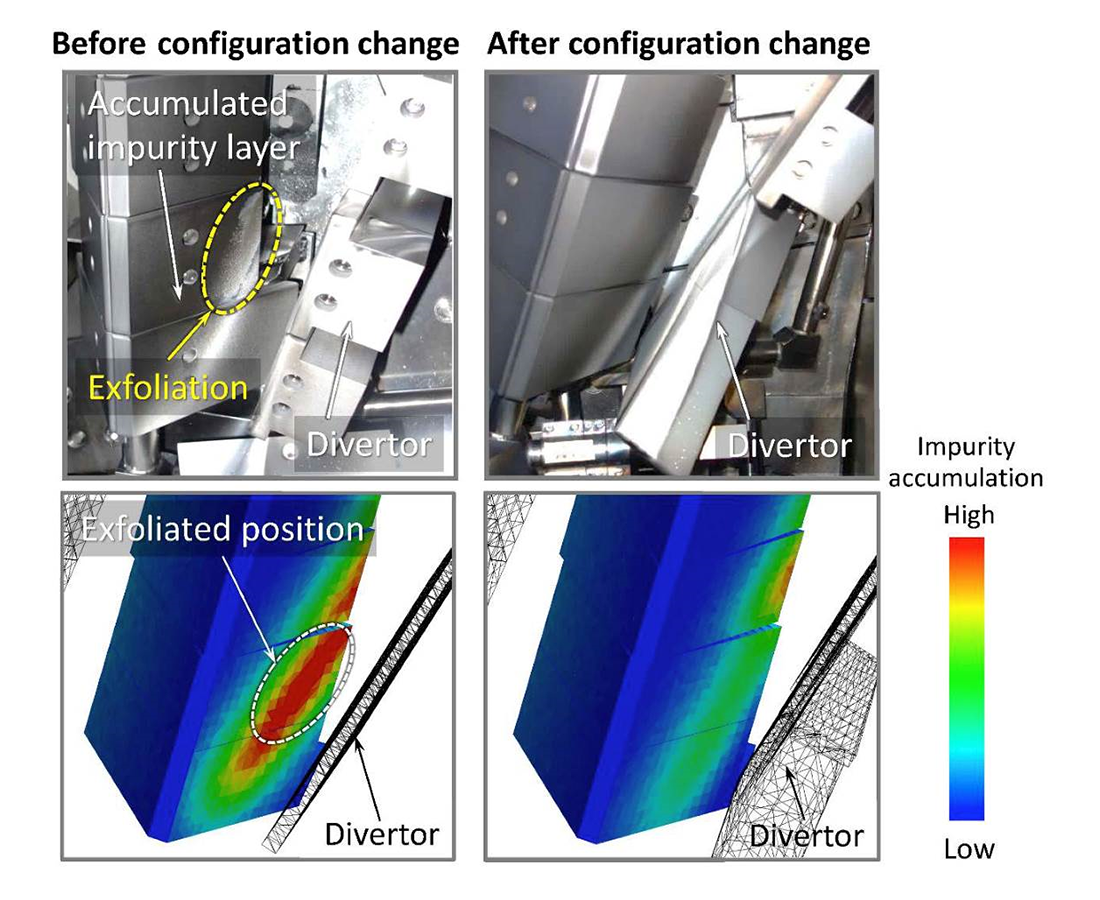Impurity accumulation layer profiles in the Large Helical Device have been successfully reproduced by simulation
In LHD, impurity layers have been accumulated on the in-vessel components every plasma discharge. The layers are very fragile and are characterized by the exfoliation property. Plasma discharges can be interrupted by the exfoliated impurity layers entering the plasma. Our simulation has successfully reproduced the areas where the impurity layers are accumulated. It will contribute to the stable operation of future nuclear fusion reactors.

In the Large Helical Device (LHD), for every plasma discharge, impurity layers have accumulated on the in-vessel-components. The layers are very fragile and are characterized by an exfoliation property. Plasma discharges can be interrupted by the exfoliated impurity layers entering the plasma. Our simulation has successfully reproduced the areas where the impurity layers have accumulated. It will contribute to the stable operation of future nuclear fusion reactors.
Electricity is generated by stably sustaining plasmas in nuclear fusion reactors. Impurities are produced when high-temperature and density plasmas attach to the vacuum wall and divertor regions in fusion reactors. In long pulse plasma discharges, layers containing impurities are formed by the accumulation in the vacuum wall and near the divertor region. Since the layers are very fragile, dust particles containing the impurities are released by the exfoliation of the impurity layers when thick layers are excessively formed. It has been found that plasma discharges are interrupted by the radiation energy loss due to impurity ions when the dust particles enter the plasma in the operation phase. The prediction of the accumulation area of the impurity layers in nuclear fusion reactors has been required because we can take measures to control the accumulation from the prediction, leading to a more stable operation of fusion reactors.
The figure shows the photos of the LHD divertor taken after an experimental campaign before the change of the divertor configuration (the upper left). Dark accumulated impurity layers and a trace of the exfoliated layers were found in the divertor region. Many small daust particles originating from the exfoliated impurity layers can disturb the sustainment of a stable plasma discharge operation. In order to solve this issue, a part of the divertor was changed to reduce the impurity layers. The upper-right photo shows the divertor taken after an experimental campaign after a change of the divertor configuration. Impurity layers with no exfoliation were found in the divertor region. It proves that the change in divertor configuration is effective for sustaining the stable plasma discharges by controlling the formation of the dust particles.
A NIFS research group tried to reproduce the profile of the accumulated impurity layers in the LHD divertor region before and after the change in configuration, using the three-dimensional plasma-wall interaction simulation code (ERO2.0) which has been developed by researchers at the Forschungszentrum Julich (FZJ) in Germany. The lower-left and lower-right figures show a simulation of the profile of the thickness of the impurity layers before and after the change in divertor configuration, respectively. They reveal the formation of thick impurity layers (red area) before the change in divertor configuration, which reasonably reproduces the actual situation shown in the upper-left photo.
The exfoliated position is quite consistent with the area with thick impurity layers in the simulation. The lower-right figure indicates the simulation after the change in the divertor configuration, which presents no formation of the thick impurity layers (leading to no exfoliation of the layers). The simulation is consistent with the actual divertor situation shown in the upper-right photo.
This research proves that the ERO2.0 simulation successfully reproduces the thickness and profile of the impurity layers accumulated in the LHD vacuum vessel and divertor region. It means that the ERO2.0 code can predict the areas where the impurity layers are accumulated in future nuclear fusion reactors. Thus, the ERO2.0 code is applicable to find effective measures for controlling the excessive accumulation of the impurity layers. It is expected that the code will contribute to a more stable plasma discharge operation in future nuclear fusion reactors.
This work was performed by M.Shoji and G.Kawamura at NIFS, in an international collaboration with J.Romazanov and A. Kirschner et al. at the Forschungszentrum Jülich (FZJ) in Germany.
This research result was published on December 14, 2020 in Plasma and Fusion Research, an online journal by the Japan Society of Plasma Science and Nuclear Fusion Research.
